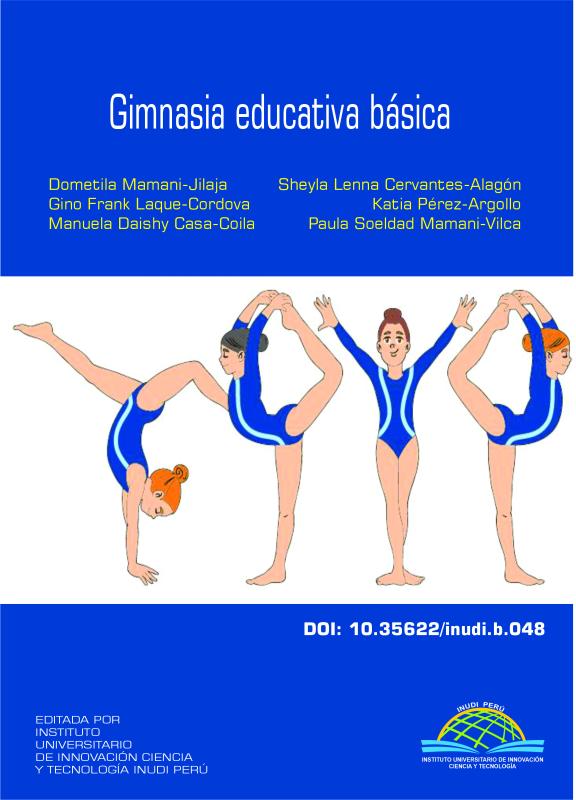Basic educational gymnastics
Keywords:
basic gymnastics, children, exercises, learning, programSynopsis
The book was adapted from an investigation whose objective was to determine the effect of the application of the DEPREPCEP Program in the learning of Basic Gymnastics in girls from the Gymnastics League of Puno (Perú). The study was an experimental application type, with a pre- and post-test design of a single group. The study population was 60 girls and the sample was 30 girls from the Puno Gymnastics League. For data collection, the Gymnastics Checklist was used as an instrument. For data analysis, percentage statistics were applied and to test the hypothesis, the T Student statistical test, and as a result, in the gymnastic program, 100% obtained a bad grade in almost all the basic gymnastics exercises before the application of the program. and after application of the program the performance of these gymnastic exercises is performed excellently in more than 50% of the girls. Comparing these results with the evaluation after the application of the DEPREPCEP Program, learning improves significantly. With the Student's t-test, the proposed hypothesis is confirmed, because it has been verified that there are significant differences (p=0.000) between the results of the pre-test and post-test. Therefore, the application of the DEPREPCEP Program has a significant effect on the learning of Basic Gymnastics in girls from the Puno Gymnastics League. In conclusion, the DEPREPCEP Program improves the performance capacity and physical strengthening of the organism in girls.
References
Araujo C. “Manual de ayudas en Gimnasia, Editorial Paidotribos”. España. 2004
Chávez M. "Gimnasia Educativa Básica". Puno-Perú 1995. Pág. 40
Durivage J. Educación y Psicomotricidad, Pedagogía para la primera infancia. 2da Edic. Trillas. Mexixo:1999
Estroner J. “Gimnasia y recreativa”.Editorial Sistes-Barcelona.2005. Pag.503
Gran Enciclopedia de Los Deportes. Edita Cultural S.A. Madrid-España.2002.pag.642
Ginés J. "Gimnasia Deportiva Básica". Primera Edición Madrid - España.1986. Pág. 219
Gomes F. “Gran Enciclopedia de los Deportes”. Edita Cultural S.A.Madrid – España.2002
Gallegos L. “Dinámica de juegos recreativos” Inicial Primaria Tercera Edic.-Perú 2002
Jurgen y Palmillo. Gimnasia Y Juegos infantiles. Tercera Edic. 2000
Liselott D. “Deportes y Juegos para niños de 5 a 7 años”. Edic. Paidos Barcelona. 2008
Marti I."Diccionario Enciclopédico de Educación".Ediciones SEAC. España, 2003.Pág. 242.
Muska Mosston, Sara Ashworth "La Enseñanza de la Educación Física-La Reforma de los Estilos de Enseñanza".Editorial Hispano Europea S.A Segunda .Edición.1996.Pág. 35
Neyra F. "Gimnasia Artística Femenina". Lima – Perú 1996. Pág.30
Palomino P. “Diseños y Técnicas de Investigación Educativa” Décima Edición. Editorial. Titikaka FCEDUC. UNA.Puno- Perú -2002
Pérez MJ. Miguel J. "Gimnasia para todos".Octava Edición. Editorial Hispano Europea S.A. Barcelona-España 1984.Pág. 15.
Pila A. "Educación Físico Deportiva-Enseñanza Aprendizaje". Ediciones. 1985. Pág. 165
Puelles D. “La Educación Física y el nuevo enfoque pedagógico”. Ediciones Abedul.Lima. 2001 pág.130
Rojas S. “Guía Metodológica de la Gimnasia Deportiva Escolar” Primer. Edic. Lima-Perú 1979
Ramos O. “La Educ. Física y Psicomotricidad en la edad escolar” STUMPP. ULRICH ESPAÑA-2006
Ramos O. "Gimnasia Deportiva Básica". Edición Madrid – España” Gran Enciclopedia de los Deportes. 2002.
Ulrich Stumpp. “Adquirir una buena condición Física jugando más de 100 juegos de entrenamiento para mejorar la resistencia, la velocidad, la fuerza y la flexibilidad”. Editorial Paidotribo. 2da Edic. Barcelona-España. 2002

















